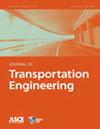Improved Speed Control Strategy for Mixed Traffic Flow Considering Roadside Unit
Q Engineering
引用次数: 0
Abstract
The information exchange among vehicles and road infrastructure with wide sensing range can be accomplished by roadside units (RSUs). Communication delays occur and are influenced by different approaches of deployment of RSUs, which increases the complexity of vehicle automatic control in a mixed traffic flow. Therefore, a speed control strategy was proposed for mixed traffic flow considering RSU deployment distance, interaction radius, and communication delay, aimed at enhancing traffic safety and efficiency. The characteristics of RSU deployment were modeled as functions, where an adaptive efficiency function was proposed to evaluate different RSU deployment plans. An improved speed control model was then developed based on the characteristics of the RSU in the mixed traffic flow. In addition, numerical analysis and simulation were carried out to evaluate vehicle stability and traffic throughput based on the improved speed control model. The analysis results show that the proposed model is stable under different updating frequencies, with the best stability achieved when the velocity update frequency is 500 and the velocity update time interval is 0.01 s. Moreover, it was found that the spatial occupancy rate increases with the increment of penetration rate of autonomous vehicles, which improves the rate by at least 20% compared to the no-control scenario. Additionally, the average speed is also increased by 30% while under the influence of communication delays. This paper investigated the relationship between characteristics of RSUs and traffic performances, which is essential for DOTs to develop an effective RSU plan to adapt to the mixed traffic flow.考虑路边单元的混合交通流改进速度控制策略
具有宽传感范围的车辆与道路基础设施之间的信息交换可以通过路边单元(rsu)来完成。在混合交通流中,不同的rsu部署方式会对通信延迟产生影响,从而增加了车辆自动控制的复杂性。为此,提出了一种考虑RSU部署距离、交互半径和通信时延的混合交通流速度控制策略,以提高交通安全和效率。将RSU部署的特征建模为函数,提出了一种自适应效率函数来评估不同的RSU部署方案。基于混合交通流中RSU的特性,建立了改进的速度控制模型。此外,基于改进的速度控制模型,对车辆稳定性和交通吞吐量进行了数值分析和仿真。分析结果表明,所提模型在不同更新频率下都是稳定的,其中速度更新频率为500、速度更新时间间隔为0.01 s时稳定性最好。此外,研究发现,随着自动驾驶汽车渗透率的增加,空间占用率也会增加,与无控制场景相比,空间占用率至少提高了20%。此外,在通信延迟的影响下,平均速度也提高了30%。本文研究了道路交通单元特征与交通性能之间的关系,为制定适应混合交通流的有效道路交通单元方案提供了理论依据。
本文章由计算机程序翻译,如有差异,请以英文原文为准。
求助全文
约1分钟内获得全文
求助全文
来源期刊

Journal of Transportation Engineering
工程技术-工程:土木
CiteScore
1.22
自引率
0.00%
发文量
0
审稿时长
3.6 months
期刊介绍:
Information not localized
 求助内容:
求助内容: 应助结果提醒方式:
应助结果提醒方式:


